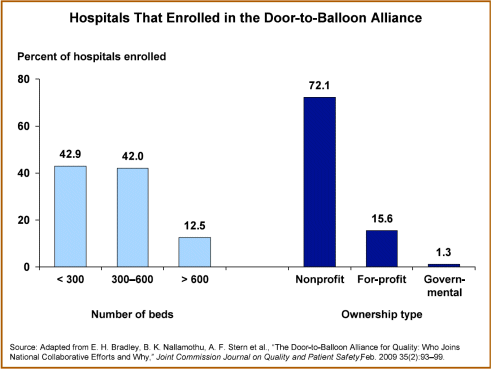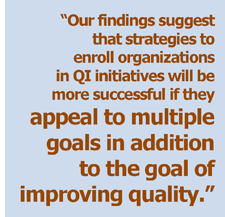An abstract is available at: http://www.ingentaconnect.com/content/jcaho/jcjqs/2009/00000035/00000002/art00004.
Synopsis
Improving quality and "doing the right thing" were the main reasons hospitals gave for enrolling in the Door-to-Balloon (D2B) Alliance—a quality improvement program designed to help hospitals implement strategies to improve treatment for heart attack patients. This survey of 797 hospitals found that other motives for joining the alliance included improving market share, meeting regulatory and accreditation requirements, and enhancing reputation. Overall, hospitals that enrolled tended to be larger and not-for-profit.
The Issue
More than 900 hospitals participate in the Door-to-Balloon (D2B) Alliance, a quality improvement program launched by the American College of Cardiology to save lives by reducing "door-to-balloon" times—the time needed before a heart attack patient receives a potentially lifesaving intervention, like angioplasty. The alliance was formed to achieve D2B times of 90 minutes or less. Strategies to improve D2B times include activating the catheterization laboratory with a single call, staff arrival within 20 to 30 minutes of a page, prompt data feedback, senior management support, and a team-based approach to care. Although such collaborative efforts are increasingly used to promote improvement, little is known about the types of health care organizations that enroll and their motivations for participating.

Key Findings
- Hospitals that enrolled in the D2B Alliance were significantly more likely to be larger, nonprofit, and teaching hospitals than those not enrolled in the program.
- Hospitals that joined D2B during the first phase of enrollment already employed many of the evidence-based strategies associated with reducing treatment times for heart attack patients.
- A desire to improve the quality of patient care was the most commonly cited reason for enrolling in the alliance.
- Respondents mentioned several additional reasons for participating in the collaborative effort, including: gaining access to the tool kits and interventions developed by the D2B Alliance, helping their hospitals improve market share, ability to get enhanced reimbursement from the Centers for Medicare and Medicaid Services, meeting regulatory and accreditation requirements, and enhancing hospital prestige and reputation. Several respondents said that joining the D2B Alliance was "the right thing to do."
Addressing the Problem
Looking at D2B Alliance enrollment as a model, researchers, policymakers, and funding agencies can expect to invest a substantial  amount of time to achieve adequate participation in collaborative quality improvement efforts, say the authors. More thought should be given to the role of early enrollees—who tend to be opinion leaders—in fostering greater participation. The authors also suggest the use of certain tactics, such as seeking positive media coverage for participants and appealing to a variety of organizational goals.
amount of time to achieve adequate participation in collaborative quality improvement efforts, say the authors. More thought should be given to the role of early enrollees—who tend to be opinion leaders—in fostering greater participation. The authors also suggest the use of certain tactics, such as seeking positive media coverage for participants and appealing to a variety of organizational goals.
About the Study
The researchers analyzed data from a Web-based survey completed by 797 hospitals that joined the D2B Alliance between October 2006 and June 2007. Respondents included hospital quality improvement directors, nurse managers, catheterization laboratory directors, emergency department directors, emergency medicine physicians, cardiologists, and clinical managers. The study also compared characteristics of D2B Alliance hospitals with 654 hospitals that perform angioplasty procedures but did not join the alliance.


